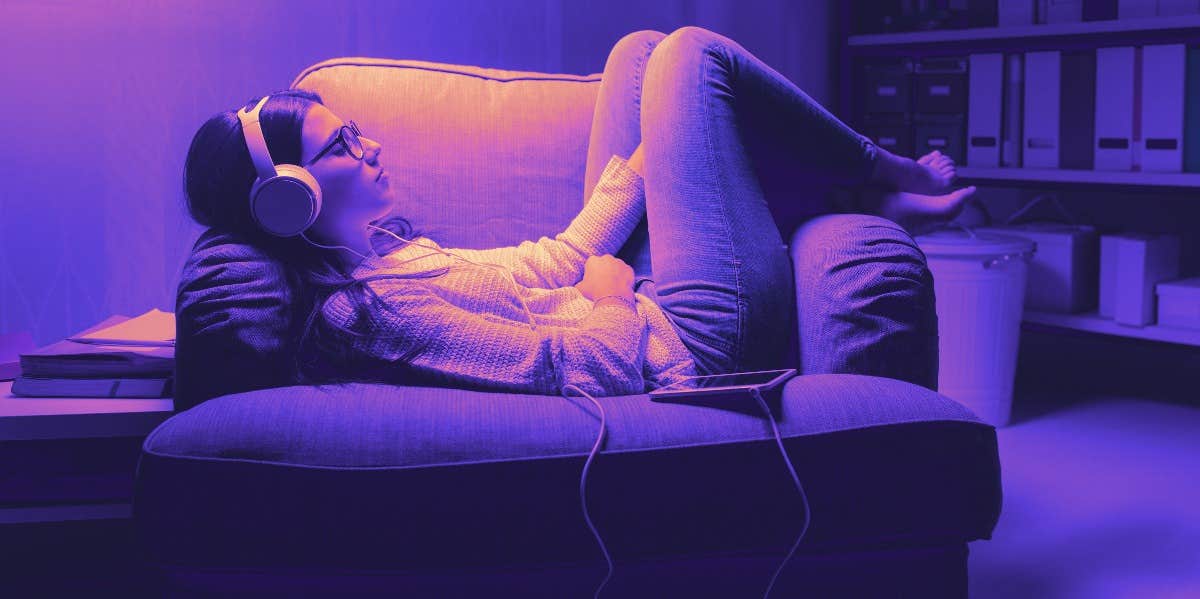How Pink Noise May (Or May Not) Help You Sleep Better
It's like white noise, but better.
 Stokkete / Shutterstock
Stokkete / Shutterstock While white noise, is the household name for the background noise that calms your mind, pink noise is taking its place as the go-to sleep aid.
What is pink noise?
Like white noise, pink noise is background sound that helps block out bothersome external sounds.
The difference between white noise and pink noise is the frequencies.
While white noise is made up of all frequencies that come through at the same high intensity, which includes undesirable high-pitched sounds. Think of the sound you might get from TV static or air conditioners.
Pink noise, on the other hand, is more subdued as the lower frequencies are more pronounced. This is more like the sounds that ocean waves or rainfall make.
Pink noise is believed to be optimal background noise for sleep and relaxation.
Background noise in general works by giving your brain something consistent to focus on while you sleep, helping to mask abrupt external sounds such as cars honking their horns or someone yelling outside your bedroom window. It’s also been proven to help people fall asleep faster.
And though white noise is included in this type of background noise, a 2018 study found that listening to white noise while you sleep can actually “accelerate the aging of the brain,” likely due to the high-pitched frequency of white noise.
Pink noise’s more balanced frequency is thought to be more desirable to the ears and brain.
Not only can it block out annoying sounds while you sleep, but according to a 2017 study, listening to pink noise while sleeping can also improve your memory.
Researchers found that study participants who listened to pulses of pink noise throughout their sleep cycle had better memory recall the following day.
There are many different colors of noises.
White noise
Contains all frequencies of sound at the same intensity. Examples include TV static and a whirring fan.
Pink noise
Contains all frequencies of sound with more intensity in the lower frequencies. For example, a waterfall or ocean waves.
Brown or red noise
Contains all frequencies of sound with more intensity in the lower frequencies, similar to pink noise, but with even more power behind the lower frequencies. For example, steady rainfall or a running shower.
Blue or violet noise
Contains all frequencies of sound with more intensity in the higher frequencies. For example, a hissing steam spray.
Black noise
Contains zero frequencies of sound. For example, complete silence.
There are some potential drawbacks to listening to pink noise.
While listening to pink noise is not generally regarded as harmful, some researchers warn against making it a long-term habit.
For one, it’s possible to become dependent on background noise to sleep.
Like the Pavlov effect, turning pink noise every night as you lay down for bed conditions your brain so that when you hear pink noise, your brain knows it’s time to sleep. Over time, you may find that without that pink noise, you can’t fall asleep.
It’s also possible that pink noise can lead to hearing loss over time.
According to the CDC, “Noise above 70 dB over a prolonged period of time may start to damage your hearing.” For comparison, a washing machine or dishwasher registers at that 70 decibel mark while normal breathing registers at about 10 decibels.
Whether you’re using a noise machine or a speaker, make sure the sound isn’t up too high.
Further, though the 2018 study focused on white noise, it’s proof that more research needs to be done on prolonged exposure to background noise of any kind and the potential negative effects.
Pink noise isn’t the only way to get a good night’s sleep.
It’s important to practice good sleep hygiene to make sure you’re getting a good night’s sleep every night.
Things like leaving your phone outside of the bedroom, consistently following a bedtime routine, and going to sleep at the same time every night can contribute to getting better rest.
Micki Spollen is an editor, writer, and traveler. Follow her on Instagram and keep up with her travels on her website.
